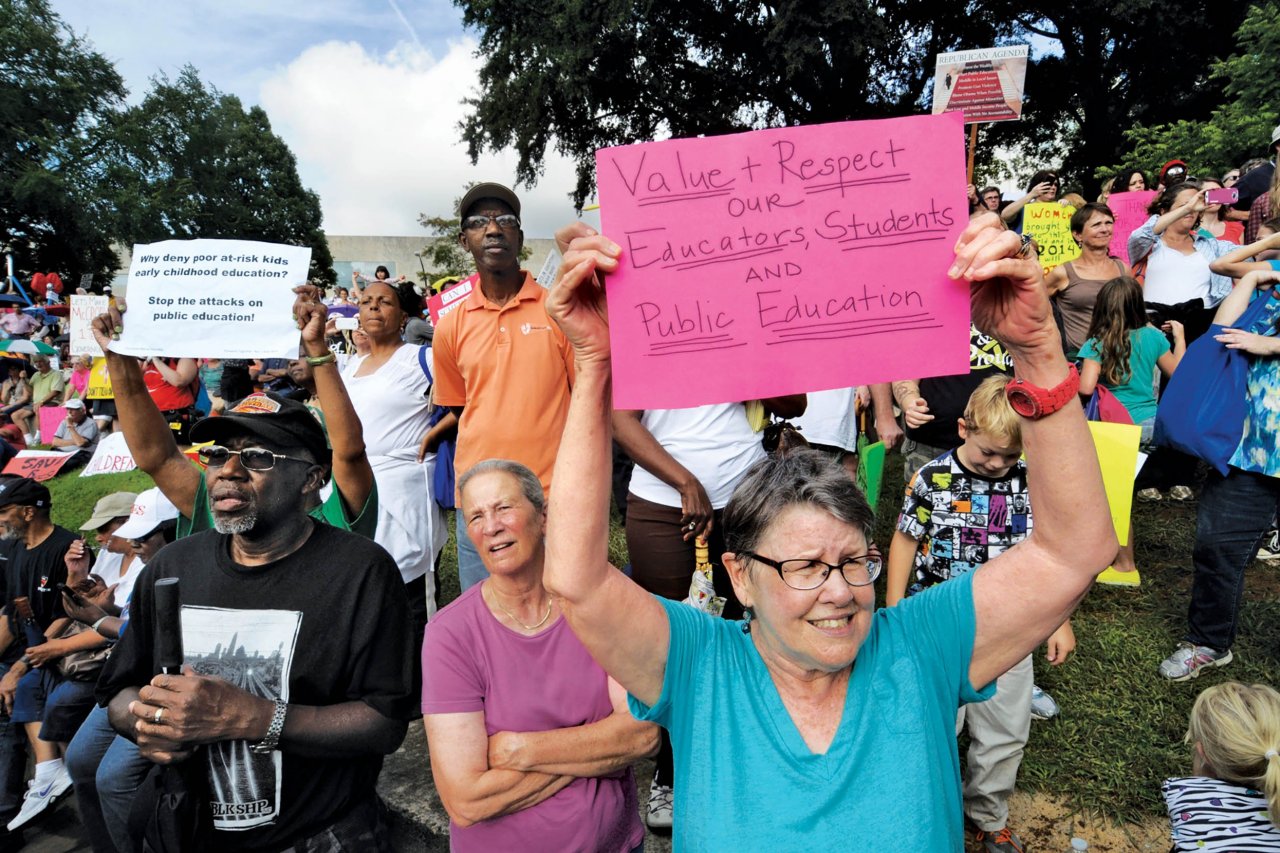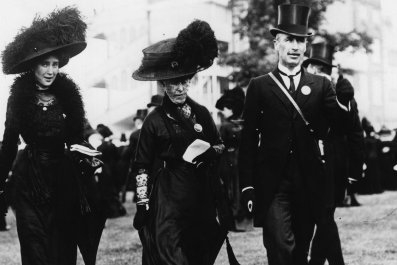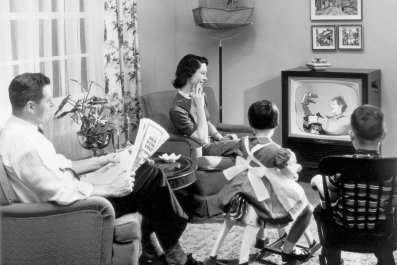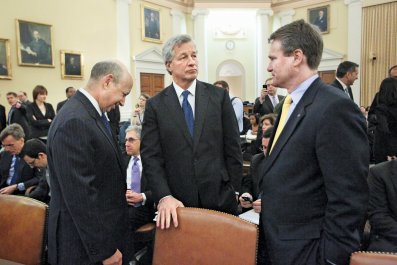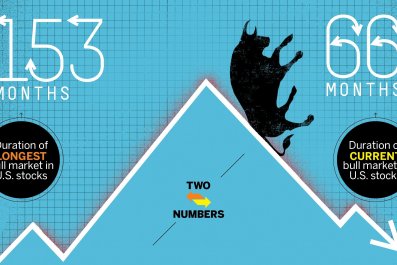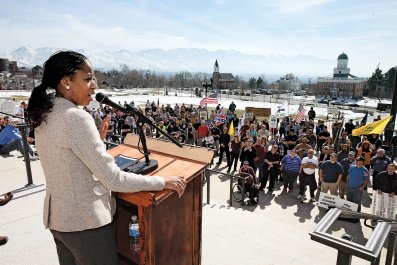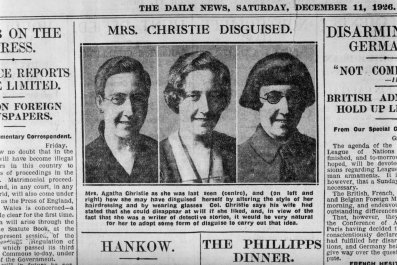On a stormy Friday night last month, the local Democratic headquarters in High Point, North Carolina was overflowing. As rain pounded outside, more than a hundred packed into a small industrial-park office space for a chance to shake hands and take their picture with Democratic Senator Kay Hagan.
A freshman Senator, Hagan is in the fight of her life this year against Republican challenger Thom Tillis, the speaker of the state House. Her race was supposed to be a prime chance for Republicans to pick up a seat on their way to gaining control of the U.S. Senate.
But it's not going as well as Republicans had hoped.
Hagan's remarks were half pep talk, half stump speech, with her supporters murmuring approval when she urged them to vote early and booing when she mentioned her opponent's record. When she stopped speaking, chants of "Go Kay! Go Kay!" filled the room.
Among her most devoted supporters, Hagan is a star. But the genius of her campaign is that it's not actually about her, it's all about her opponent. By keeping the spotlight firmly on Tillis, Hagan is poised to buck national trends and win in a solidly conservative state while fellow Democrats around the country appear headed to defeat.
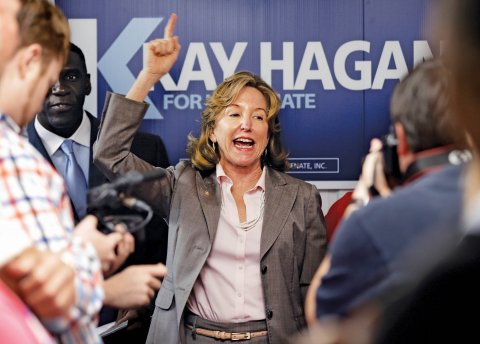
What sets North Carolina apart is what Tillis himself dubs the state's "conservative revolution." With inadequate budgets and shrinking tax revenue, Republicans over the past three years have turned North Carolina into a laboratory of libertarian economics and social conservativism. As the National Journal reported last year, North Carolina is "where the GOP's wonderland is real."
A little too real perhaps. While the state's economy is improving—as it is nationwide—North Carolinians are beginning to see what happens when you slash state revenues and state spending: While the rich get a tax cut, the state runs out of money for important things like education.
"You cannot shrink the size and scope of government to a point where you starve your public school system," Democratic consultant Brad Crone told Newsweek. "We don't want to become Kansas."
He mentions Kansas because its ultraconservative fiscal experiment isn't going so well there, either.
The state's Republican governor, Sam Brownback, championed the deepest tax-cut plan in America. The goal, he said last year, was "to create a red-state model that allows the Republican ticket to say, 'See, we've got a different way, and it works.'"
Conservatives cheered. The libertarian Cato Institute in Washington, D.C. recently released its annual fiscal scorecard, rating each governor on their tax and spend record, and Kansas and North Carolina tied for first place.
But then Kansas's economy began to lag behind its more free-spending high-taxing neighbors. As a result, state revenue shortfalls soon led to budget cuts, particularly to education. Schools shut their doors for good and more kids were squeezed into fewer classrooms. Now, opinion polls show Brownback tied with his Democratic challenger in a state far redder even than North Carolina.
So the midterms will put to the test whether deep tax and spending cuts translate into winning campaigns.
"Did they go too conservative? I would say yes," Crone said of the Republicans in Raleigh. "Too far, too fast. Social issues. The tax policies, too. The tax cuts are designed to basically starve government and to shrink the size of government and to slow down the spending curve on public education."
Hagan faced serious obstacles to a second term. Democrats struggle to turn out key constituencies in midterm elections when the choice of president is not on the ballot. And President Barack Obama's flagging approval ratings are depressing the national appeal of his party. (Obama's approval figure hovers at around 41 percent in North Carolina.) Hagan's path to reelection looked fraught.
But now, with November 4 just around the corner, Hagan is expected to be re-elected by a slim margin. Since the end of the summer, she has maintained a small yet consistent lead in most polls, if often only by two or three points. Election forecasters FiveThirtyEight.com give Hagan a 71 percent chance of winning. Hagan's lead could still evaporate as Republicans make a last-ditch effort to save Tillis with a $6.5 million cash infusion for television ads in the last three weeks of the race.
Still, Hagan is outperforming Democrats in states like Iowa and Colorado—states that, unlike North Carolina, voted for Obama in 2012.

The Tillis campaign has tried hard to turn the focus of the race back on Hagan, painting her as a rubber stamp for the unpopular president's priorities. And they are claiming success. "The race has really become nationalized," Tillis spokesman Daniel Keylin told Newsweek. Keylin pointed to recent Tillis ads that focus on Hagan's national security record and the claim that she voted for the 2009 stimulus package to gain personally from its generous grant program. (Hagan has responded to both attacks with her own ads.) If Tillis has succeeded in moving the debate from his conservative record to hers, then Tillis could still have a chance.
Hagan, meanwhile, will try to keep the election all about Tillis. When Newsweek asked Hagan what issues would galvanize her supporters to vote, the senator didn't talk about her own record or what she wanted to accomplish. It was all about the failure of her opponent's ultraconservative experiment. "I think you see the record that Speaker Tillis has built in the state House. I think it's the most destructive record we've seen in North Carolina," she said.
The Conservative Experiment
Obama shocked the nation by winning North Carolina in 2008, the first time a Democratic president had won the Southern state since 1976. But since then North Carolina has moved not just red, but deep red.
In 2010, Republicans gained control of the state legislature for the first time in over 100 years. Two years later, the state narrowly went for Republican Mitt Romney at the top of the ticket and Republican Pat McCrory ascended to the governor's mansion.
In complete control of the state government for the first time since Reconstruction, Republicans set to work implementing an ultraconservative agenda. It's hard to think of a prominent GOP policy that has not been adopted in North Carolina.
State spending as a share of the economy hit a 40-year low, tax rates were slashed, the state declined to expand Medicaid to 500,000 uninsured North Carolinians under the Affordable Care Act and a controversial education package reformed teacher pay. The legislature passed tort reform, cleared the way for the controversial practice known as fracking for gas and passed an anti-Shariah bill to protect the state against the (nonexistent) threat of Islamic law.
The legislature cut benefits for the unemployed, defunded Planned Parenthood, placed onerous restrictions on abortion clinics, loosened gun restrictions and passed the most restrictive voter ID law in the country. (A local political columnist dubbed the voting law "a cynical move worthy of Frank Underwood," a reference to the power-hungry congressman on the Netflix series House of Cards, because the law is expected to suppress turnout among minorities, young people and the seniors.)
At the center of all this ultraconservative activity was Tillis, the self-declared "leader of a conservative revolution in Raleigh."
"This election is a referendum on what the legislature has done," said Becki Gray of the libertarian-leaning John Locke Foundation, a public policy think tank where she works with state lawmakers to adopt conservative policies. "Thom Tillis has a really aggressive record of getting a lot of stuff done, so all of that is on the table. That's fair game to be critical of," she said.
It's a little early to tell what the GOP's reforms will mean for the state's economy, but so far austerity budgets in North Carolina have had the most visible effect on public education. The Hagan campaign has exploited the frustrations of teachers and parents with a simple attack: Tillis cut taxes for the wealthy, then cut education for everyone else.
"The most important decision they made was last year enacting the biggest tax cut in North Carolina state history," said Allan Freyer, an economist at the left-leaning North Carolina Justice Center, a research and advocacy group. "It will lead to the biggest revenue shortfalls we have probably ever experienced over the next 10 years."
The plan reduces three separate income tax brackets to a single flat tax at 5.75 percent and cut the corporate tax rate to 5 percent. Estate tax has already been repealed. Gray stresses that everyone in North Carolina has enjoyed a tax rate cut because the flat rate is lower than the previous lowest bracket. But in order to help pay for the cuts, the state expanded the regressive sales tax and eliminated a number of tax credits that particularly benefit low-income people, including the state Earned Income Tax Credit. According to some analyses, the average tax burden on low and middle income North Carolinians went up.
In the first three months of this fiscal year, the state took in $313 million less in revenue than the previous year and $61 million below what the legislature expected to raise, even when the tax cuts were taken into account. To Gray, that's $313 million that have stayed in taxpayers' pockets, which is the point of cutting taxes. To liberals, however, falling revenue is a harbinger of even more cuts to education.
The nonpartisan Institute on Taxation and Economic Policy estimates that the new North Carolina tax plan will cost the state over $1 billion this fiscal year compared to the past one. "That's about equivalent to the entire community college budget," said Tazra Mitchell, a budget analyst at the Justice Center. "So that's not a small chunk of change."
"Education is the largest portion of the budget, so when you shrink state revenues by $600 million to $1 billion a year out of a $20 billion budget, you are effectively capping the amount you can spend on education," Freyer explained.
Cuts in education spending have become the centerpiece of Hagan's attacks on Tillis. She repeatedly claims he has cut $500 million from education; Tillis counters by saying he has increased education spending by $1 billion since 2011. The truth is that while spending has gone up in dollar terms, it has not risen fast enough to account for the state's growing population and keeping up with inflation." "You can spend more but still fall short of what's needed," said Mitchell.
Textbook funding is a perfect example. "In the current budget, they appropriated $24.3 million for state funding for textbooks," Mitchell explained, a $900,000 bump from the previous year. "Yet, in fiscal year 2010, it was $120 million," adjusted for inflation. In other words, the textbook budget is a small fraction of what it was a few years ago.
"Perhaps the general assembly was a little too aggressive, they got out a little bit ahead of themselves with the reduction in the textbook funding," Gray said, calling concerns about textbooks "legitimate."
Beyond the funding issue, the Republican legislature enacted an education reform package that replaced a 36-step salary structure with a six-step one. The result is that when the legislature raised teachers' pay this summer, new teachers saw a raise while rises for veteran teachers' were negligible.
Sandie Cecelski, 57, is in her 28th year as a teacher in the North Carolina system, where she teaches high school biology. Her textbooks are 12 years old and falling apart. She says she hasn't had a raise in five years. Neither has the woman she was commiserating with when I met her—59-year-old teaching assistant Sarah Bailey, who has worked in North Carolina schools for 21 years.
The two educators huddled on the sidelines of a pro-Hagan rally in Wilmington. They had never met before, but it didn't take long for them to share stories about low pay and how their friends who are moving to states like Texas and South Carolina where teachers are better paid. They blame Tillis and the Republicans in Raleigh.
"I'm actually getting more involved [in the election] this year than I've ever been," Bailey said. "It's very, very important he does not make it to Washington, D.C."



